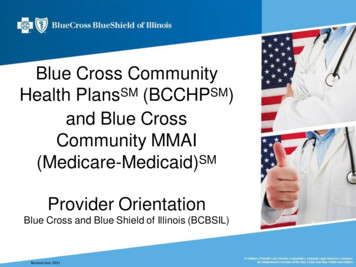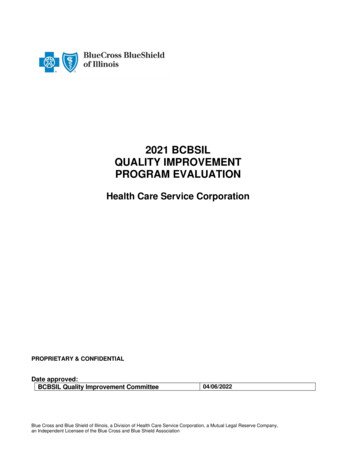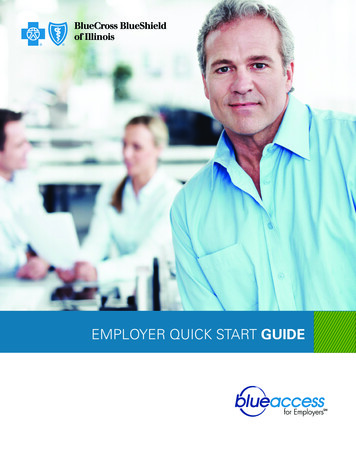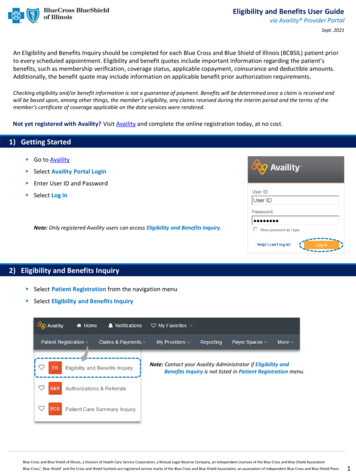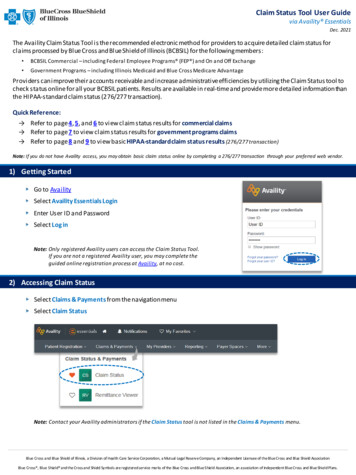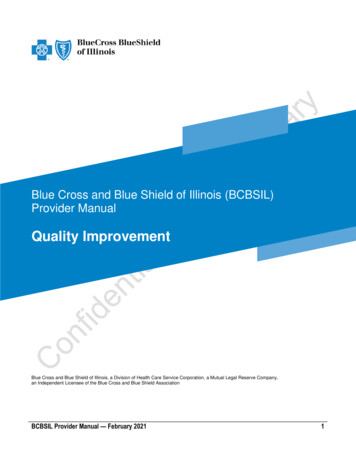
Transcription
Blue Cross and Blue Shield of Illinois (BCBSIL)Provider ManualQuality ImprovementBlue Cross and Blue Shield of Illinois, a Division of Health Care Service Corporation, a Mutual Legal Reserve Company,an Independent Licensee of the Blue Cross and Blue Shield AssociationBCBSIL Provider Manual — February 20211
Programmatic StructureMissionThe Health Care Service Corporation, a Mutual Legal Reserve Company, (BCBSIL or company) Mission is “Topromote the health and wellness of our members and communities through accessible, cost-effective, qualityhealth care.”PhilosophyThe BCBSIL philosophy is to provide products and services of the highest quality and value with a direct focus onsupporting providers and meeting the needs of customers.The BCBSIL Quality Improvement (QI) Program is based on a view that the process for delivery of medical careand services can be continuously improved, and that data-driven monitoring and evaluation are an integral part ofthe managed care quality improvement.The program integrates fundamental management techniques, existing improvement efforts and disciplined use ofanalytical tools for continuous process improvement.Purpose and ScopeThe purpose of the BCBSIL QI Program is to provide focus and structure of our quality improvement philosophy.The QI Program focuses on areas within products that are important to our customers and are critical in achievingcorporate goals in a manner consistent with corporate values to identify, monitor and evaluate clinical, service andmember experience improvement opportunities.GoalsThe following goals were designed to assist providers in meeting quality improvement and member experiencegoals: Monitor and ensure compliance with State and Federal regulatory requirements and accreditationstandards.Implement a standardized and comprehensive quality improvement program which will address and beresponsive to the health needs of the member population, inclusive of serving the culturally andlinguistically diverse membership.Develop a comprehensive, meaningful and soundly executed Population Health Management strategy.Provide staff with training, information, and tools that help identify cultural and linguistic barriers andsupport culturally competent communications.Assess the cultural, ethnic, racial and linguistic needs of members to deliver culturally competentservices.Monitor and support the needs of members who have disabilities, to help improve their access to healthcare.Conduct patient-focused interventions with culturally competent outreach materials that focus on race,ethnicity, and language needs.Develop, implement, and monitor action plans to improve medical and behavioral health care, as well asservices.Identify opportunities to improve the outcomes, promote delivery and effective management forpopulations with complex health needs, which may include the following conditions: physical ordevelopmental disabilities, multiple chronic conditions, mental illness, organ transplants, HIV/AIDS,progressive degenerative disorders, metastatic cancers, and severe behavioral health conditions.BCBSIL Provider Manual — February 20212
Quality Indicators and Monitoring ActivitiesOngoing monitoring of specific quality indicators is an important component of the QI Program. Indicators aregenerally selected based on important aspects of care for BCBSIL members, as well as their objectivity,measurability and validity, utilizing medical/surgical, behavioral health, pharmacy and race/ethnicity/language datasources. Indicators may derive from the following existing measure and data-sets:Indicator Data SourcesA variety of internal and external data sources may be utilized in quality indicator monitoring. In part, they include: Claims Medical records Surveys Enrollment data External data sources Health assessments Complaints and appeals databases Local and National benchmark data Centers for Medicare and Medicaid Services (CMS)Program Descriptions and QI Focus AreasActivities to Improve Patient Safety and Safe Clinical PracticeThe role of BCBSIL in improving patient safety involves fostering a supportive environment to assist providers inmaintaining a safe practice. BCBSIL collaborates with network providers to improve the safety of clinical care andservices. As part of this collaboration, providers agree that BCBSIL may use provider performance data for qualityimprovement activities, which include but are not limited to: Evaluating clinical practices against aspects of practice guidelines related to patient safetyInvestigating quality of care issuesUsing Utilization Management (UM) data to promote patient safetyDistributing information to members, practitioners and providers which improves knowledge regardingclinical safety as it relates to self-careDeveloping quality improvement activities that promote patient safetyDistributing information to members, practitioners and providers which facilitates informed decisionsbased on safetyLeveraging various BCBSIL pharmacy programs that address patient safety, including: BCBSIL’s Pharmacy Benefit Manager (PBM), Prime Therapeutics, offers the concurrent DrugUtilization Review (DUR) program which screens prescriptions at the point of sale for potential drugproblems such as drug-to-drug interactionsPrime Therapeutics works with BCBSIL to identify and notify members and practitioners who may beaffected by product recalls or voluntary drug withdrawalsOngoing retrospective drug utilization review (RDUR) programs tell practitioners about a differentmedication management issue quarterlyProvider Onsite VisitsProvider site visits are conducted in accordance with Illinois Department of Public Health (IDPH) guidelines andregulations which include HMO high-volume behavioral health practitioners.BCBSIL Provider Manual — February 20213
Health EquityHealth Equity Strategies:Governance and Structure- Health Equity Steering Committee OverviewThe Health Care Service Corporation (HCSC) Health Equity Steering Committee (HESC) focuses on theachievement of health equity for its’ members by reducing the impact that health disparities have on members'quality of life. The HESC works to operationalize efforts to eliminate disparities in health and health care deliveryby applying an equity lens to company-wide business practices. The HESC also enables interdisciplinary actionswhich will improve health equity for HCSC members and the communities HCSC serves.The HESC is comprised of five workstreams that uniquely address a specific health equity priority:1. Advance Data Maturity – Institutionalize HCSC’s ability to collect, monitor, analyze, and report race,ethnicity, language, and sexual orientation, and gender identity data.2. Enhance the Healthcare Workforce – Lead annual provider and clinical associate implicit bias andcultural competency trainings to reduce health care disparities. National leader in increasingunderrepresented minorities in health care workforce pipeline.a. Provider Education: Cultural Competency and Implicit Bias Physician Diversity – Throughpartnership and collaboration providers will be offered various opportunities to enhance culturalcompetency in patient care to improve patient outcomes. In addition, implicit bias trainingopportunities will be available to assist providers with identifying biases that could be affectingcare delivery and contributing to disparities in care.3. Optimize Member Engagement – Enhance personalized, culturally specific messages and channels toimprove health outcomes for members of diverse racial/ethnic, and socioeconomic backgrounds.Leverage digital and offline tools to optimize member engagement.4. Align Community Investments – Diversify and align community investments to strategic and timelyhealth equity priorities.5. Eliminate Health and Healthcare Disparities – Implement strategies that identify, monitor, and eliminatehealth disparities (gender/racial/ethnic/language/economic) through clinical and provider interventions.a. Data Collection and Analysis of Race, Ethnicity, and Language (REL), Sexual OrientationGender Identity (SOGI) and Social Determinants of Health (SDoH) data – The goal is to makeREL and SOGI data consumable to inform business practices that consider SDoH as a factor toimprove health equity.b. Value Based Incentives – Implementation of mandatory disparities reduction and socialdeterminant of health goals and incentives in value-based care agreements and clinicalprograms.BCBSIL Provider Manual — February 20214
Health Equity Pilots & Initiatives: Institute for Physician DiversitySM is a part of Blue Cross and Blue Shield of Illinois’ health equity strategy.This program enables collaboration with academic medical centers and teaching hospitals across thestate of Illinois and focuses on opportunities to improve diversity in the physician workforce.Rural Health - An integral component of the organization’s health equity strategy, which includes theconvening of CMOs, administrators, and legislatures to discuss and address rural health disparities inIllinois. By removing barriers and advancing social factors that impact member’s health and wellbeing weseek to dramatically improve the lives of the individuals living in rural communities.Cultural Competency and Implicit Bias Provider Education addresses the intersection of health equity,cultural competency and implicit bias, providers have an opportunity to complete two computer-basedtraining modules for continuing education credits. Providers interested in exploring supplemental culturalcompetency trainings can visit the Office of Minority Health Think Cultural Health webpage.Provider Forums offer ongoing provider education opportunities offered through BCBSIL Blue Universityin partnership with BCBSIL network operations and the Office of the CMO. Topics vary and highlight theclinical and quality imperative to address health disparities and social determinants of health.Value Based Incentive Pilots: Within health care delivery, we have taken steps to begin integrating goalsfor reducing health care disparities within provider agreements. There is an increased focus on disparitiesin asthma, diabetes, hypertension management, and rural health. We embrace our role in partnering withproviders on health equity.BCBSIL Provider Manual — February 20215
BCBSIL Quality Improvement CommitteeThe BCBSIL Quality Improvement Committee (QI Committee) is responsible for providing oversight and direction tothe Quality Improvement Program. The QI Committee brings multidivisional staff together with employers, providersand members to: Review and approve the annual BCBSIL Quality Improvement Work Plan Monitor and analyze reports on quality improvement activities from subcommittees Provide oversight of delegated activities Review and approve the annual BCBSIL Quality Improvement Program Evaluations Review and approve the Medical Management Quality Improvement Projects Recommend policy decisions Analyze and evaluate results of quality improvement activities Review and analyze significant health care disparities in clinical areas Review and analyze information, training and tools to staff as well as practitioners to support culturallycompetent communication Review and analyze onsite audit results Review, analyze and evaluate member complaints Review and analyze member and provider appeals Review, analyze and evaluate populations with complex health needs Ensure practitioner participation in the QI program through project planning, design, implementation and/orreview Implement recommended actions Ensure follow-up, as appropriate Maintain signed and dated meeting minutesBCBSIL Provider Manual — February 20216
Practitioner Credentialing and Re-credentialingBCBSIL has implemented criteria for the selection and retention of network practitioners and providers. Allcontracted practitioners and providers must meet the applicable selection criteria.The credentialing/re-credentialing process is designed to assess physician and provider compliance with BCBSILparticipation criteria and the ability to deliver care and service to members. Physicians are re-credentialed at leastonce every three years, or more frequently as determined by the Credentialing Committees. The scope ofindividual physicians credentialed and re-credentialed includes MDs, DOs, DPMs, DDSs, and contractedindependent practitioners, such as nurse practitioners, chiropractors, physical therapists, mental healthprofessionals, and essential community providers, as appropriate.The physician and health care professional/practitioner credentialing/re-credentialing process include primarysource verification consistent with National Committee for Quality Assurance (NCQA) and Utilization ReviewAccreditation Commission (URAC) standards, states and federal regulatory requirements, as well as CMS andBCBSIL requirements.BCBSIL monitors information from licensing agencies and updates from the National Practitioner Data Bank(NPDB) regarding sanctions and restrictions on licensure or scope of practice according to schedules dictated bythe individual agencies. Additionally, the Debarment Screening Tool is reviewed to identify individuals and/orparties that have been sanctioned or debarred by any of the following six government listings: The Office of Foreign Asset Control Specially Designated Nationals (OFC)The Office of Foreign Asset Control Sanctioned Countries (OSC)The Office of the Inspector General (OIG)System for Award Management (SAM) Excluded Parties List System (EPL); Note: All exclusion recordsfrom GSA’s Excluded Parties List System, including Office of Personnel Management (OPM) were movedto SAM EPL on November 21, 2012.The Foreign Evaders Sanction List (FSE)The Illinois Department of Public Aid - IL Medicaid Program (ILSEL)The Texas Health and Human Services Commission - TX Medicaid Program (TXSEL)When participating physicians and providers are identified through any of the above queries, the physicians andproviders are brought forth for disciplinary action up to and including termination.BCBSIL Provider Manual — February 20217
Members Communication, Rights and ResponsibilitiesIn accordance with federal and state regulatory requirements, and accreditation needs, BCBSIL is committed toensuring our member’s rights and responsibilities are respected, upheld, and available in various communicationmediums to the member and participating providers.The purpose is: To build up member confidence in the health care system, by making it easy for members to be involvedin their own health care. To strongly support the importance of a good health care provider-patient relationship. To emphasize and support the importance of the members' rights and responsibilities with regard to theirown health.Components of the QI Program incorporating elements of member rights may include: Policies on inquiries and complaints Policies on appeals Policies on quality of care complaints Access standards Member involvement in satisfaction surveysBCBSIL additionally has written policies that state its commitment to treating members in a manner that respectstheir rights, and its expectations of members’ responsibilities, including: Member Rights and Responsibilities Information Disclosure Choice of Providers and Plans Access to Emergency Services Participation in Treatment Decisions Respect and Non-Discrimination Confidentiality of Health Information Complaints and AppealsBCBSIL also holds forth certain expectations of members with respect to their relationship to the Plan and theirindividual health care practitioners. These rights and responsibilities are reinforced in member and providercommunications, including the BCBSIL website. Other communication methods of the member rights andresponsibilities statement include in writing, by mail, fax, or email. The Plan is responsible for assuring amechanism is in place for existing members and practitioners to receive this information and any revisions as theyoccur. BCBSIL is committed to the cultural, linguistic and ethnic needs of our members; thus, communicationtools are available to support the diverse membership.BCBSIL Provider Manual — February 20218
Member EducationBCBSIL features information in member publications and on the BCBSIL website to improve member knowledgeabout methods by which members may reduce the likelihood of errors in their care. An example is EMMISolutions, online health education videos. EMMI programs provide practical information in an easy to understandformat to empower members to manage their care more effectively and participate in treatment decisions. EMMISolutions allows clinical staff to “prescribe” videos to members participating in care management programs.Members receive an email with a link to a video tutorial relevant to their care plan. These modules support moreinformed decisions and help members understand symptoms, treatments, side effects and risks. Members canpause to take notes and the system generates a document to discuss with their physician.In addition, BCBSIL has an online community called “Connect Community” where members can find contentrelated to various diseases and prevention categories. This includes blog articles, videos, and links toauthoritative sources of information (e.g. associations). Connect Community readers can comment on posts andshare content with others via social media channels including Facebook, Twitter, and LinkedIn. For retail and onexchange small group members, new specific pages for Diabetes, Coronary Artery Disease, Colorectal CancerScreening, and Flu Shot were created to select appropriate content for the Connect sites and EMMI video contentrelated to those topics for our members. Members are directed to the pages via email and direct mail.Member ExperienceThe monitoring, evaluation and improvement of member experience are important components of the QIProgram. This is accomplished using surveys, as well as through the aggregation, trending and analysis ofmember complaint and appeal data, including the following categories: quality of care, access, attitude andservice, billing and financial issues and quality of practitioner office site. In addition to the administration ofsurveys, BCBSIL encourages members to offer suggestions and express concerns utilizing customer servicetelephone lines and request for comments in survey instruments.The following surveys are utilized in the assessment of member experience: Continuous Tracking Program (CTP): population-based member satisfaction survey which is administeredon an ongoing basis to a sample drawn from the entire enrolled population. Case Management Survey, if applicable Behavioral Health Member Satisfaction Survey, if applicable Condition Management Survey, if applicable Special Beginnings Survey, if applicable Consumer Assessment of Healthcare Provider and Systems (CAHPS ), if applicable Qualified Health Plan Enrollee Experience Survey (EES), if applicable Customer Service Post-Interaction survey, if applicableBCBSIL may also solicit input from members, employers, providers, and facilities by the following means: Ad-hoc advisory groups Face-to-face meetings Telephonic encountersBCBSIL Provider Manual — February 20219
HEDIS For selected products, Healthcare Effectiveness Data & Information Set (HEDIS) Performance Measures resultsare evaluated on an annual basis to monitor improvement. HEDIS data are collected from claims, encounters,and may be supplemented with medical chart review. HEDIS data submitted to National Committee for QualityAssurance (NCQA), the Blue Cross and Blue Shield Association (BCBSA) and other entities, are audited by anNCQA certified auditor.Quality Rating System (QRS) Measure SetAs part of the Affordable Care Act (ACA) requirements, Centers for Medicare and Medicaid Services (CMS)developed the Quality Rating System (QRS) to: Inform consumer selection of Qualified Health Plans (QHPs) offered through a Health InsuranceMarketplace (Marketplace) Facilitate regulatory oversight of QHPs Provide actionable information to QHPs for performance improvementQHP and Multi-State Plan (MSP) issuers that offer coverage through a Health Insurance Marketplace are requiredto submit third-party validated QRS clinical measure data and QHP Enrollee Survey response data to CMS as acondition of certification.Qualified Health Plans (QHP) Quality Improvement Strategy (QIS)As an issuer participating in a Marketplace, BCBSIL will implement and report on at least one QualityImprovement Strategy (QIS) in accordance with section 1311(g) of the Affordable Care Act. The QIS will covereach state in which the Plan has participated in the Marketplace for two or more consecutive years andenrollment was 500 enrollees within a product type by State during the designated period of time.BCBSIL will review data to identify the appropriate QIS for each Marketplace that includes at least one of thefollowing: Activities for improving health outcomes; Activities to prevent hospital readmissions; Activities to improve patient safety and reduce medical errors; Activities for wellness and health promotion; and/or Activities to reduce health and health care disparities.BCBSIL will use market-based incentives to improve the quality and value of health care and services specificallyfor Marketplace enrollees. All QIS activities will be linked to an incentive as defined by CMS. The market-basedincentive types to be included are: 1) increased reimbursement or 2) other incentive. The incentive will be aprovider market-based incentive, an enrollee market-based incentive, or both.Each year, the status of each QIS will be determined based on the following: Continue the QIS without modification Continue the QIS with some modifications Discontinuing the QISIf a decision is made to discontinue a QIS submitted during a prior period, a new QIS will be selected for theapplicable Marketplace.Continuity and Coordination of CareContinuity and coordination of care are important elements of care and as such are monitored through the QIProgram. BCBSIL identifies opportunities for improvement in the continuity and coordination of medical care.Initiatives are selected across the delivery system, including settings, transitions in care and patient safety. Inaddition, coordination between medical and behavioral health care is also monitored.BCBSIL Provider Manual — February 202110
Practice GuidelinesBCBSIL has developed and implemented both clinical practice and preventive care guidelines. The guidelines aredeveloped and derived based upon a variety of sources, including recommendations from specialty andprofessional societies, consensus panels and national task forces and agencies; review of medical literature andrecommendations from ad hoc committees. Clinical practice and preventive care guidelines are updated at leastevery two (2) years or more frequently, as needed.Preventive care guidelines include age and gender-specific and perinatal evidence-based recommendations.Clinical practice guidelines such as Asthma, Chronic Obstructive Pulmonary Disease (COPD), and Diabetesinclude evidence-based recommendations.Service Quality ImprovementThe services provided by the Plans support members and the health care delivery system. Further, satisfactionwith BCBSIL is often derived from the quality of service the members receive. Service standards have beenestablished to prevent issues, whenever possible, and provide consistent, timely and accurate information andassistance to members, physicians, providers and other customers. The standards are routinely monitored andreported to the appropriate committees. Surveys and complaints are monitored to ensure the standardsestablished are appropriate and meet the needs of the organization and customers.Provider Quality ProgramsBCBSIL manages several quality-related provider programs such as HMO Illinois , our Accountable CareOrganizations, in which we share savings for provider systems able to reduce costs while improving quality, andthe Blue High Performance Network (Blue HPNSM), which BCBSIL is offering in coordination with the Blue Crossand Blue Shield Association and Blue Cross plans nationally.BCBSIL Provider Manual — February 202111
Care Management ProgramsBCBSIL has active programs for the development, implementation, and assessment of care managementprograms that coordinate care for members with chronic conditions and risk factors. BCBSlL WellbeingManagement (WBM) Programs bridge medical management to an integrated, member-centric approach. ThePrograms are designed to pro-actively identify and “reach-out” to select BCBSIL members based on individualmarket or employer group specific utilization, case and condition management parameters.WBM combines the traditional elements of medical care management with health advocacy components to createa management strategy that is sensitive to the care needs of the individual member. The care managementstrategies include:Condition Management Programs are an integral part of the WBM programs, which focus on a series of intensiveinterventions to alter the normal course of a specific chronic disease. The approach to condition management ischaracterized by three steps:1. Identification and stratification: Identification of members with specific chronic illness occurs throughconcurrent review of inpatient cases, physician referrals and analysis of medical claims, face to faceencounters, pharmacy, laboratory data, predictive modeling data, health assessments (HAs), as well asreal time referrals.2. Institution of a condition management intervention based upon severity: The interventions vary fromprogram to program because they are condition specific, but in general they emphasize clinically-basededucation and counseling based on nationally recognized clinical practice guidelines. Motivationalinterviewing techniques are utilized with members to undertake and maintain behavior change.3. Evaluation of the effectiveness of the program: Relevant outcomes include analysis of changes inhospitalization rates and emergency encounters, closure of clinical gaps in care, member satisfaction withthe program, quality of life or functional status, and cost savings.Health Promotion and Education Activities which focus on the provision of information and tools to members toincrease knowledge and the ability to self-manage their care.Lifestyle Management Programs are a component of WBM designed to assist members in making a change intheir behavior to reduce negative medical consequences resulting from lifestyle choices and to increase theiroverall quality of life. The Lifestyle Management program is administered by health coaches who are licensedprofessional counselors, licensed masters/clinical social workers, registered dieticians, certified exercisespecialists and case managers with expertise in behavioral modification, weight management and tobaccocessation. Co-management and integration with other components of WBM including Condition Management andSpecial Beginnings ensures a holistic approach to maximize member’s health and productivity.Case Management facilitates access to care for members requiring complex coordination or resources, especiallywhen the required care is not available in the member’s service area. As part of complex case management, highcost claimants, patient alerts (i.e., ER visits and transportation) are high priority for intervention. Rare diseasemanagement is offered to members who have select complex chronic diseases determined to be potentially highcost, but rare within the member population. The goal of the program is to improve clinical, utilization and patientsatisfaction outcomes.Care Coordination and Early Intervention (CCEI) focuses on quality related to care coordination including preadmit/post discharge outreach, education related to patient safety/medication compliance, discharge planning,and episodic case management for all products. Member outreach/engagement occurs in both the inpatient andoutpatient setting with a focus on preventing hospital readmissions and non-trauma ER visits.The Special Beginnings Program assists members in obtaining access to appropriate prenatal care. Pregnantmembers of select employer groups are eligible for the program, which includes the identification of a potentialhigh-risk pregnancy and screening for potential depression. Case management is provided for any memberidentified as high-risk and includes ongoing coordination of care by case managers with expertise in obstetriccase management. The program identifies and utilizes facilities appropriate for high-risk deliveries and neonatalemergencies.BCBSIL Provider Manual — February 202112
Behavioral Health – BCBSIL’s Behavioral Health Care Management (BHCM) Program is designed as anIntegrated Service Delivery Model. Integration of behavioral health with medical care management supportscontinuity and coordination of care between medical and behavioral health physicians and professionalproviders. The model effectively integrates health care management programs that optimize member/provideraccess, facilitates navigation of benefits/services, and enhance information sharing/exchange to identify and closegaps in care. Members requiring co-management of behavioral health and medical conditions will be identifiedearly on, resulting in coordination of care, clinical efficiency, improved outcomes and reduced costs over time.Blended Model Care Management Program – Programs may include Behavioral Health (BH) and Complex CaseManagement Programs. All Care Management Programs are developed based on Clinical Practice Guidelines.The Clinical Practice Guidelines are derived from a variety of sources, including recommendations from specialtyand professional societies, consensus panels, national task forces, federal agencies, review of medical lit
The BCBSIL Quality Improvement (QI) Program is based on a view that the process for delivery of medical care . Enhance the Healthcare Workforce - Lead annual provider and clinical associate implicit bias . source verification consistent with National Committee for Quality Assurance (NCQA) and Utilization Review Accreditation Commission .

